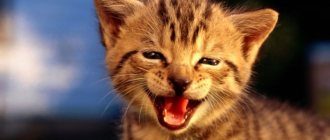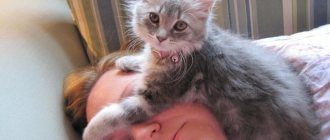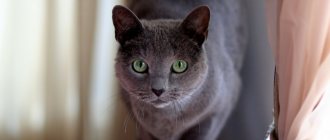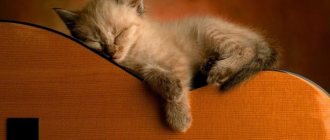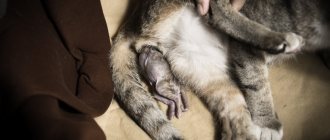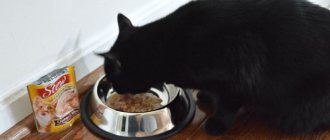A cat shows its mood through body language
To the average person, felines seem illogical and incomprehensible creatures. Here the cat is caressing. And after five minutes it’s already hissing and ready to bite off your leg. What with her? Maybe she's sick? Or did the person offend her?
In the article, we looked at what cat body language is and how pets express their mood through movements and poses. You will also learn how to learn to understand cat body language.
Cat sign language: poses and movements
When a person lives with cats, it would be good to learn to understand what they want and what they are thinking about. Cat language is not something extremely complex. Watch your pet and you will understand the difficulties of translation.
How to understand a cat's language by looking at its tail
In the course of research conducted by scientists from different countries, it became known that cats are capable of making over 60 different sounds. Thus, cats can vibrate in a variety of ways and also express their emotional state through body language.
The most powerful pointer in cats is the tail. Unlike a dog, a cat's tail is much more mobile and serves as a kind of balancer.
In addition, the tail of cats is an indicator of mood. A sharply raised tail, pointing straight upward, means great enthusiasm, greeting and expression of joy. Such a signal can be intended not only for the owner who has returned from work, but also for his relatives whom the cat has met on the street. The greeting involves not only the tail, but also the bend of the body and a soft purr.
The following states of a cat can be determined by the tail:
- A drooping tail means the cat feels frightened or slightly displeased. In such cases, it is better to leave the animal alone.
- Twitching of the tail or sharp swings indicate a degree of nervousness. The cat wants to be alone and it’s best not to disturb it. In this case, the animal does not intend to enter into a discussion with its owner.
- Twitching the tip of the tail is a manifestation of strong concern. The animal understands human speech and may show dissatisfaction about this if it hears unflattering reviews about itself.
- The raised hair on the tail is a sign of intense rage and undisguised anger. The cat is preparing to attack.
- A tucked tail between the hind legs is a feeling of fear.
Cats can manipulate people
Cats have a much stronger bond with people than any other pet. They know how not only to bring joy to their owners, but also to manipulate them.
A group of behaviorists from the University of Vienna analyzed the behavior of 41 cats and their owners, and also found out through tests how playful the animals were and how sociable their owners were.
Researchers have determined that cats and people have a strong influence on each other. The greatest mutual understanding was observed in the relationships between extroverted women and young, active animals. For them to communicate successfully, minor hints are enough - for example, a raised tail signals a desire for friendly contact. At the same time, cats skillfully use the love of their owners, in particular, in order to get more food.
Cats and people have a strong bond with each other. “A person and a cat know each other’s inclinations and preferences well. Their relationships are based on mutual attraction, ease of interaction, games, love and social support,” says one of the authors of the study, Dorothy Gracie.
Such relationships are typical for people, but practically never occur in nature. Cats behave like small children who have not yet learned to talk, the researchers say, emphasizing that the results of their work allow us to take a fresh look at these animals.
Communication using limbs
If a pet gently moves its furry paws and at the same time releases its claws, then the animal is content and in a state of complete peace. Being in a good mood and feeling bliss, cats begin to mentally return to their early years. As a small kitten, the animal sucked its mother's milk and kneaded her belly with its paws. In addition to moving its paws, the cat begins to purr gently and soothingly.
Note! In such moments of bliss, the cat can forget itself and begin to release its claws, digging into the owner’s body. It is not recommended to scold or sharply pull your pet, as this can greatly offend an impressionable animal. It is best to carefully move the cat and pet it.
Very often, cats show their love for their owner by gently hugging them with their paws. But if the paw is raised sharply upward, with its claws extended, it means that the cat is preparing to defend itself and is determined.
The movements of a cat's paws and body also relate to methods of communication with humans.
Paws
When a cat tramples or moves its paws, it is happy and content. The animal will demonstrate its alertness if it freezes and raises its front paw.
If there is a lack of affection or attention, the cat will begin to “butt” or touch the owner with its paw. If a cat crouches on its front legs, it is experiencing aggression and is ready to attack. If it squats on its hind legs, the mustachioed pet is in a confused state.
Body movements
If an animal rubs against its owner’s leg, it trusts him. In this state, the pet is relaxed and, most often, begs for something - either a cutlet, or just a little affection. In addition, in this way the owner will be “marked” by the smell of the pet - as a sign of his affection.
If a cat walks next to its owner, rubs against his legs and at the same time meows, the cat is probably waiting for something.
The position of the pet with its front paws tucked under itself signals its poor health. The cat may be in pain at this moment or perhaps very physically tired. This indicates the cat's tense state.
A cat curled up is a wonderful state in which the animal feels warm and comfortable.
The cat lay down on its side and stretched its paws forward - it relaxed and felt safe. A cat interested in something will sit down, tuck its paws under itself and hug them with its tail.
Perhaps the funniest position of a cat’s body is in the “column” position. When he stands upright, with his eyes wide open and sitting on his hind legs. This is the height of the animal’s curiosity and the desire to understand what is happening.
Expressing emotions using ears and eyes
Cats' ears are excellent radars, designed to detect various sound waves. It is noteworthy that a cat in a state of wakefulness can detect the sound made by rodents at a distance of more than 20 meters. In search of a sound source, a cat can rotate its ear 180 degrees. More than 30 different muscles are involved in the ear's unique ability to bend, press, and rotate.
There are a number of emotions expressed through the position of the ears:
- A cat can express a good mood and positive attitude using its ears. In this case, they will be strictly in front at the top of the head.
- The placement of the ears in different directions or flat means that the cat is at a loss, not understanding what is happening.
- Dropped or pinned ears are a signal to attack; the pet is ready to defend itself and it is better to leave it alone.
- Ears turned and pressed back are a sign of rage and anger.
- Twitching ears means that the cat is nervous and irritated. This movement is often observed when the pet is watching a potential victim.
It’s not just a cat’s ears that can indicate the animal’s mood. The visual organ – the eyes, like people’s – can express a whole range of emotions. When a pet looks with an open, calm gaze, it means that she is happy with everything or is interested in the action taking place. There is an opinion among breeders and cat lovers that with the help of a look a cat can express its love for its owner. In this case, the animal looks straight into the eyes of its owner for a long time and devotedly, and then slowly closes its eyes.
What sounds can a cat make to communicate with its owner?
Types of meows
The cat's "language" differs in four types of sounds:
- the cat combines consonant sounds, purring and producing not nightingale trills, but trills;
- communication with vowel sounds, that is, “meow,” but variations of this “word” can be very different;
- a set of verbal combinations can be expressed by squeaking, chirping and crackling sounds - if the cat is disappointed;
- if a cat wants to warn about something, he will hiss or even growl.
According to some experts, cats' meowing is intended only for humans, and they communicate with each other at a different frequency or produce sounds that the human ear cannot detect.
Not every cat will communicate with its owner. There are species that are considered very quiet, such as the Persian or the Carthusian breed. But, for example, the Siamese’s mouth practically does not close.
Animals cannot talk, but by the cat’s gestures and the sounds it makes, you can understand its mood and what emotions it is currently experiencing - whether it is friendly, angry, or perhaps offended by something.
How to understand a cat by meowing
By meowing you can understand the whole spectrum of emotions felt by a cat. Cats express most of their emotions through gestures or facial expressions. Cats use sounds to emphasize their state or the emotions they are experiencing. In most cases, cats purr. This is a special sound created not by all vocal cords, but by vibrations in the upper register. The main purpose of purring is to express peace and love for the owner.
Note! Some owners note that the cat begins to purr, expressing its dissatisfaction or resentment.
A cat can not only purr, but also hiss, howl, chirp and make crackling sounds.
- Short cooing-like sounds are made by cats after a hearty meal, as well as while being stroked by their owner or in anticipation of a treat.
- Hissing means that the animal does not want to make contact, is very frightened and is ready to attack.
- howl and grumble during the onset of hunting. The animal shows its condition and calls the opposite sex.
- By meowing in high notes , a cat or cat is trying to attract its owner or a stranger.
- Specific sounds of chirping and crackling can be made by cats calling their grown kittens.
- But when a cat purrs with its mouth closed , it means full readiness for procreation.
Cats can produce many different sounds, differing in pitch, length and sound timbre. They are all different, but in most cases, loud sounds emitted express negative emotions, while soft and quiet ones indicate good spirits and mood.
If the animal begins to scream, making heartbreaking sounds, then this indicates that the cat requires help. Perhaps something hurts her. In addition, sharp, intense sounds made by an animal indicate a feeling of fear or anger.
Dictionary of cat sounds
Purring - calmness. Dissatisfied purring is a painful sensation. Rumbling is dissatisfaction. Meowing is a greeting and sometimes a request. An intermittent meow, similar to a squeal, is a response to human treatment. Howling is anger. A short cry is fear. Muffled purring, ending with a dissatisfied rumbling - patience has run out. Hissing is a readiness for defense, a warning about this. The restrained purr of a nursing cat is a warning to kittens about possible danger. The same thing, ending with a raised tone - a warning to a person or other creatures not to approach the kittens.
Cat sign language
Cats and kittens can express their attitude and emotional state not only with the help of their ears and voice. With the help of body language, cats can show their friendly attitude, humility, peace, arrogance, resentment and other emotions.
Having shouted or offended his pet in some other way, a person notices that the cat turns its whole body in the opposite direction from him, not paying attention to calls and appeals. Experts say that this is not so much an indicator of arrogance and arrogance as a fear of meeting the eyes of an angry owner.
When a cat shows its belly , it is a signal of a friendly attitude and a special degree of trust. The animal is in a good, playful mood and will, with great pleasure, allow itself to be stroked and cuddled.
In cases where a cat arches its back and raises the hair on its nape and tail, we can confidently say that the animal is ready for an attack and a fierce battle. On the contrary, if the pet tries to hug the floor, bend its ears and tail in order to appear visually smaller, it means that the cat does not intend to communicate and wants to be left alone.
When training your cat, teach yourself
Since cats are interested in learning new methods of communication with the owner, your initiative will help establish close interpersonal contact and achieve obedience from the pet. The more actively you communicate with your cat, the faster it will learn to understand you.
To show your cat that you are friendly and satisfied, use a raised tone of voice. To express disappointment, resentment or dissatisfaction, speak quietly and clearly pronounce hissing sounds.
Verbal communication
When communicating with your cat, try to use the same words and say them slowly. Periodic repetition will allow you to consolidate a clear associative connection.
Experiments have shown that at the age of up to 6 months, cats are able to easily remember from 30 to 70 voice messages from the owner. It is important to understand that this is not about commands or orders, but about explaining your actions.
For example, by repeating the words “sleep” every time, you can train your cat not to disturb you at night, to climb into your bed, or to ask for food in advance.
When communicating with a cat, always be consistent in your intentions.
If you need to punish your pet, do not shout or use the word “no”. The true relationship has not yet been clarified, but zoologists have proven that cats are embarrassed when they hear the word “no”, but normally perceive the words “later”, “later”, “not now” and so on.
Observations by animal psychologists have shown that stopping a cat’s actions with the word “no” most often leads to a second attempt to perform an unwanted action.
Non-verbal communication
Cats perceive non-verbal communication signals instinctively and without difficulty. You can test it on your own pet: slow blinking expresses affection and provokes the cat into close communication.
Watching your pet hesitate in its decision to jump on your bed, be silent and lightly tap your palm next to you - the pet will perceive the gesture as an invitation.
Communication by smells
At first glance, it may seem that we are talking about marking territorial boundaries. But this is not entirely true, because there is also a secret type of communication between a pet and its owner using smells.
The most important aromas with which a cat establishes contact with its owner are the elusive odors left by the animal on a person with the help of specific glands located on the chin, forehead and lips.
These glands produce special odors used for greeting (a cat pokes its face after a long absence of its beloved owner). Cats often rub against the owner’s legs, leaving as much odor as possible on the owner’s clothes, and they also rub their muzzle into the person’s face and hands in order to leave more odor on the skin.
After such secret manipulations, a person receives a whole spectrum of specific odors that accompanies him everywhere. Cats believe that the owner also marked them when he stroked their fur or head, leaving their scent in return as a sign of devotion and love.



